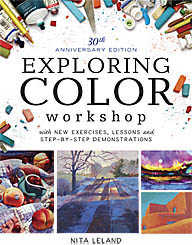Color bias
Color wheels are based on the properties of light, but pigments aren't pure like light is. Their characteristics vary in transparency, intensity, tinting strength, granulation, viscosity and staining properties. As important as these characteristics are, they aren't the key factor in color mixing. Each pigment also has a distinctive color bias that influences mixtures. Understanding color bias is essential to successful color mixing.
The dictionary says bias is a "preference or an inclination." When you call Alizarin Crimson a bluish-red, you're saying that it is a red that leans toward blue. Most pigments have such inclinations. Determine the bias in a paint color, and you can control mixtures incorporating that color. For example, to mix a good violet or purple, use a bluish-red and a reddish-blue. A yellowish-red or greenish-blue would add yellow to the mixture and dull the color, because yellow is the complement (opposite) of the color you're trying to mix. Yellow is also the third primary color, so when you want to mix bright colors, make sure there are only two primaries in the mixture.
For a more detailed explanation of color-mixing see the split-primary color-mixing system on my web site or my book, Exploring Color.
The dictionary says bias is a "preference or an inclination." When you call Alizarin Crimson a bluish-red, you're saying that it is a red that leans toward blue. Most pigments have such inclinations. Determine the bias in a paint color, and you can control mixtures incorporating that color. For example, to mix a good violet or purple, use a bluish-red and a reddish-blue. A yellowish-red or greenish-blue would add yellow to the mixture and dull the color, because yellow is the complement (opposite) of the color you're trying to mix. Yellow is also the third primary color, so when you want to mix bright colors, make sure there are only two primaries in the mixture.
For a more detailed explanation of color-mixing see the split-primary color-mixing system on my web site or my book, Exploring Color.
Labels: color, color mixing, color theory, color wheel, exploring color, split primary, tutorials





0 Comments:
Post a Comment
<< Home